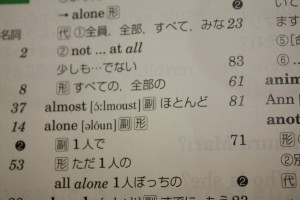eikaiwa expectations high school JHS junior high school kids Language learning teaching vocabulary
by sendaiben
14 comments
My ‘almost’ mini-lesson
Unfortunately, many students in Japan are taught that ‘almost’ in English is ‘hotondo’ in Japanese
Sadly this is not true, so over the years I have developed a short mini-lesson to correct this false impression and help students better understand the meaning of almost.
The lesson can start at any time, but it requires a trigger: one of the students must translate almost as hotondo.
Once that happens, I quickly go through the following steps:
- I point out that even though many teachers and textbooks teach this, almost is not the same as hotondo
- I pretend to trip, and then say “phew, I almost fell over just now”
- I ask the students to translate the previous sentence: “hotondo korobimashita” sounds really strange, so clearly hotondo is not a good translation here
- I tell the students I planned to go to Tokyo this morning, but ended up not going. “I almost went to Tokyo”
- “Hotondo Tokyo ni ikimashita” also sounds weird
- I offer two alternative translations for almost: mou chotto de ~ and ~wo suru tokoro datta
- I explain that hotondo is actually almost all in English: mou chotto de zenbu
Of course, this illustrates vividly the perils of learning and teaching vocabulary out of context, which provides another excellent mini-lesson for the students 🙂
Do you have any favourite mini-lessons?
You can have that one as a freebie, no royalties.
My Random House JE-EJ dictionary defines hotondo as [adverb]: almost, nearly, and gives the example “hotondo owatta”. Hmmm. No mention whatsoever of “almost all”. Double hmmm. My Taishukan’s Genius JE dictionary also has almost, nearly, about, practically, virtually, and ***then*** it says most. With nai, hotondo can mean hardly, scarcely, seldom, rarely, few, little. Yes, it’s wise to try defining it as “almost all”, but there are more ways to use it (unfortunately).
I’m with you and Richard, Ben. Just pointing out that even dictionaries don’t always give the complete (or clearest) explanations. I wonder if that’s why so many kids don’t learn it properly.
You’re right, Ben. Context is far better, and things like graded readers can help, of course. At my uni’s English Resource Center, I started subscribing to the Shukan Times newspaper this April. It has definitions in Japanese of a few bold font words in every article, so students can see that context and get the definitions simultaneously. Problem is, nobody makes use of the ERC or such resources! Getting students aware that things exist is one thing (and I try), but getting students to access them is another. Horse to water, and all.
Ben, We tried subscribing to various magazines (National Geographic regular and special travelers issues, Organic Gardening, Discover, The Scientist, and a few others like those). We thought only the foreign grad students would read them, and we got those because we knew the uni library didn’t have them. Unfortunately, no grad students made/had the time to break away from their lab research to even drop by. To this day 4 years later, I can count the no. of grad students who have visited on one hand! I could not find decent mags for our students at anything approaching their (low) reading level that would appeal to their maturity or age. If you find some, let me know.
Instead of apes, I draw a group of people without heads whenever someone says “almost people.” The visual image seems to resonate better than any explanation I’ve ever been able to come up with. I try to avoid explanations that involve translation as much as possible as I find them to often cause more confusion in the end and reinforce the tendency to rely on Japanese when deciding on appropriate English usage.
Thank you for sharing your experience and insight at Oxford Day! I loved your presentation. It was very helpful, resourcefull and intersting. This “hotondo” mini-lesson expecially the one about “almost people” was so much fun.

I used to like picking up the classic error “almost people” when students meant “most people” or “almost all people”. I’d ask what an “almost person” was. An ape?